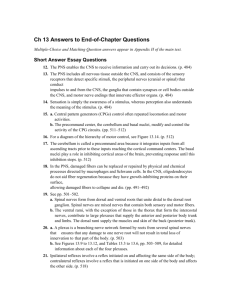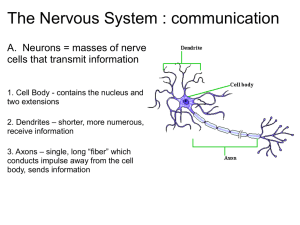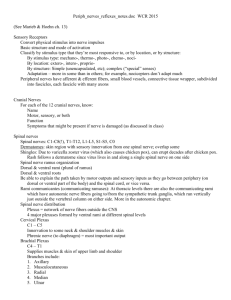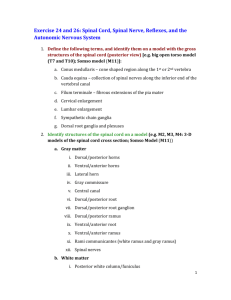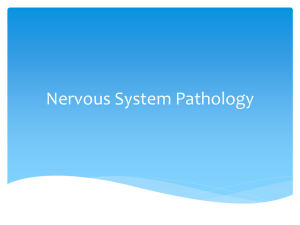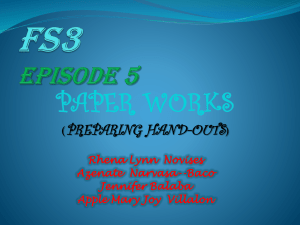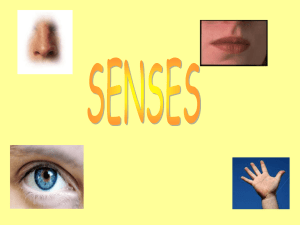Peripheral Nervous System
advertisement
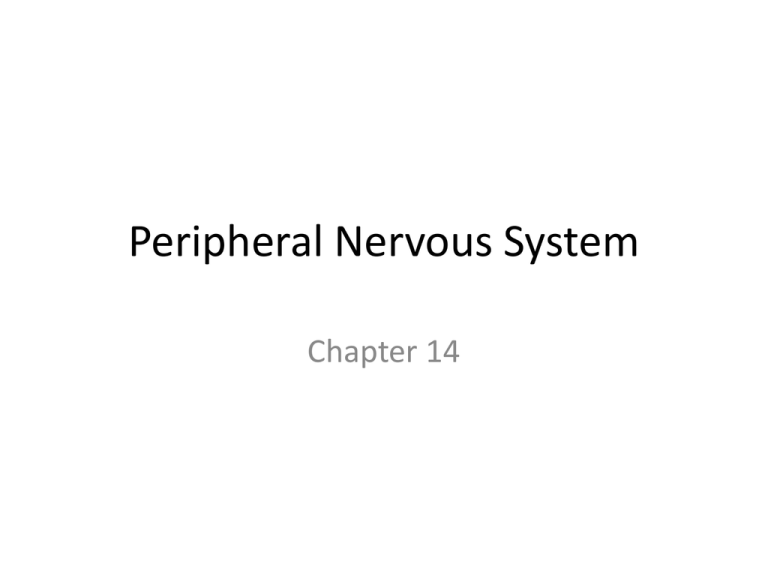
Peripheral Nervous System Chapter 14 Spinal Nerves • 31 pairs of spinal nerves are connected to the spinal cord – Numbered according to the portion of the vertebral column at which they exit • • • • • 8 cervical nerve pairs 12 thoracic nerve pairs 5 lumbar nerve pairs 5 sacral nerve pairs 1 coccygeal nerve pair – All spinal nerves carry both motor and sensory fibers so they are designated as mixed nerves Structure of Spinal Nerves • Ventral and dorsal roots join to form spinal nerves • Each spinal nerve branches into a dorsal ramus and ventral ramus. (plural = rami) Nerve Plexuses • The ventral rami subdivide to form complex networks call plexuses – All spinal nerves except T2-T12 • Each nerve that emerges from a plexus contains all the nerve fibers that innervate a particular region of the body • Four major subdivisions (Table 14-1): – – – – Cervical plexus (C1-C4) Brachial plexus (C5-T1) Lumbosacral plexus (L1-S4) Coccygeal plexus (S5 & coccygeal nerve) Dermatomes & Myotomes Dermatomes • Dermatome: a skin surface area supplied by sensory fibers of a given spinal nerve Myotome • Myotome: a skeletal muscle or group of muscles that receives motor axons from a given spinal nerve Cranial Nerves Cranial Nerves • Olfactory Nerve (I) – Sensory – Sense of smell • Optic Nerve (II) – Sensory – vision • Oculomotor Nerve (III) – Motor – Eye movements, regulation of pupil size • Trochlear Nerve (IV) – Motor – Eye movements Cranial Nerves • Trigeminal Nerve (V) – Mixed – Sensations of head and face, proprioception – Chewing movements • Abducens Nerve (VI) – Motor – Abduction of eye • Facial Nerve (VII) – Mixed – Taste – Facial expressions, secretion of saliva & tears • Vestibulocochlear Nerve (VIII) – Sensory – Balance, equilibrium, hearing Cranial Nerves • Glossopharyngeal Nerve (IX) – Mixed – Sensations of tongue, reflex control of blood pressure & respiration – Swallowing movements, secretion of saliva • Vagus Nerve (X) – Mixed – Sensations and movements of organs supplied (ex: slows heart, increases peristalsis, contracts muscles for voice production) • Accessory Nerve (XI) – Motor – Shoulder movements, turning head movements, movement of viscera, voice production • Hypoglossal Nerve (XII) – Motor – Tongue movements Cranial Nerves Acronyms • Names: On Old Olympus’ Tiny Tops, A Friendly Viking Grew Vines And Hops • Functional Classification: Some Say ‘Marry Money’; But My Brother Says ‘Bad Business, Marry Money’ Reflexes • A reflex is the action that results from a nerve impulse passing over a reflex arc – A predictable response to a stimulus – Conscious or unconscious – Somatic Reflexes • Skeletal muscle contraction – Autonomic Reflexes • Contraction of smooth or cardiac muscle; glandular secretion Somatic Reflexes of Clinical Importance • In certain diseases or after trauma to the nervous system certain reflexes may be abnormal • Testing of reflexes is a valuable diagnostic tool Stretch Reflexes • Knee jerk or patellar reflex – Extension of lower leg in response to tapping patellar tendon – L2-L4 segments of the spinal cord • Ankle jerk or Achilles reflex – Plantar flexion of the foot in response to tapping the Achilles tendon – S1-S2 segments of the spinal cord Stretch Reflexes • Biceps Reflex – Flexion at the elbow in response to tapping the brachii tendon – C5-C6 segments of the spinal cord • Triceps Reflex – Extension at the elbow in response to tapping proximal to the elbow – C6-C7 segments of the spinal cord Cutaneous Reflexes • Cutaneous reflexes result from stimulation of the skin receptors • Babinski Reflex – Reflex in response to stimulation of the outer portion of the sole of the foot (make a ‘J’ from the heel along the lateral edge through the ball of the foot) – Infant (to 1 ½ yrs): extension and fanning of toes – Children & adults: plantar flexion – Change in response due to corticospinal tract becoming fully myelinated – A + babinski’s in an adult means destruction to the corticospinal tract Cutaneous Reflexes • Abdominal Reflex – Drawing in of the abdominal wall in response to stroking the side of the abdomen – T9-T12 spinal nerves and segments of the spinal cord Quiz yourself on a sheet of paper Match the following cranial nerve with the correct function (write it out) • Olfactory A. taste, facial expression • Vagus B. hearing, balance • Facial C. sensation of head/face; chewing movements • Vestibulocochlear D. sense of smell • Trigeminal E. sensation/movement of organs Quiz yourself on a sheet of paper Warm Up: 1. What are the 3 parts of the diencephalon? Name one function for each part. 2. Differentiate between a dermatome and myotome. 3. What are the 5 sections of spinal nerves? How many spinal nerve pairs are in each section?

